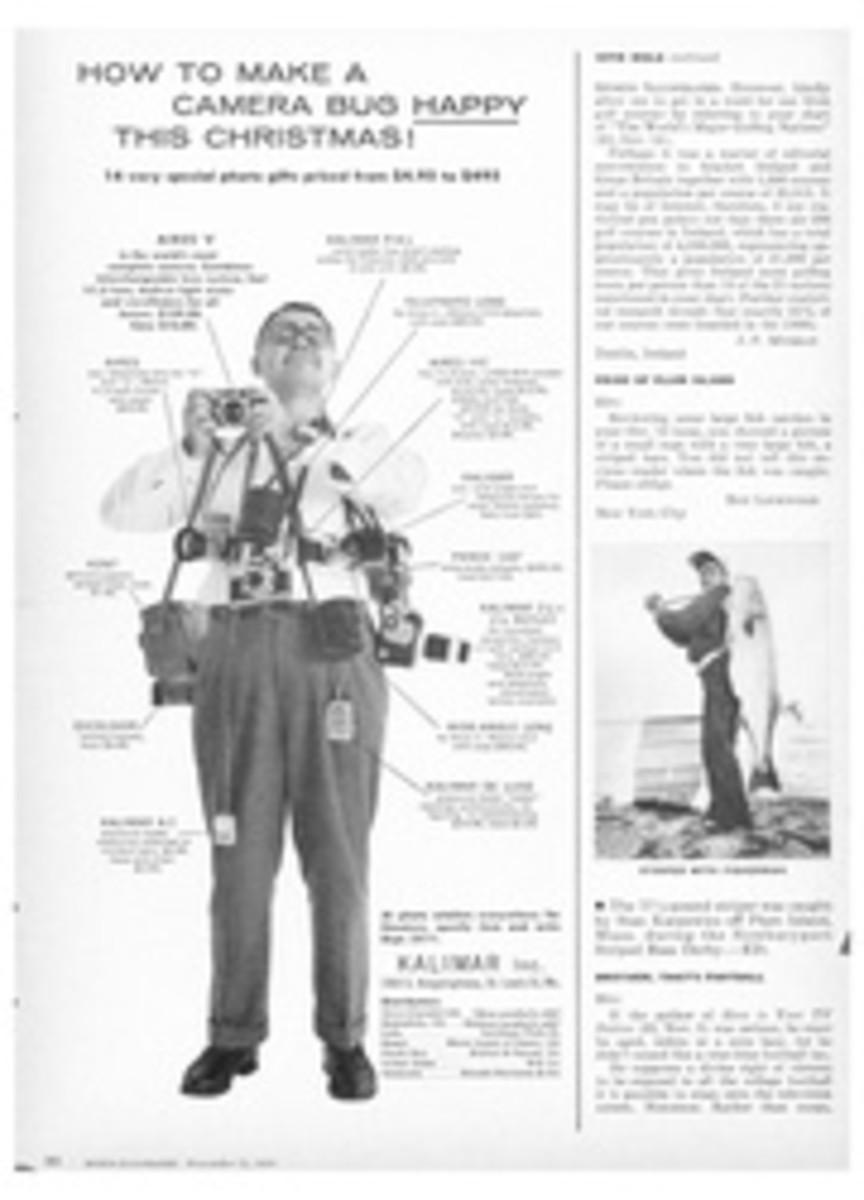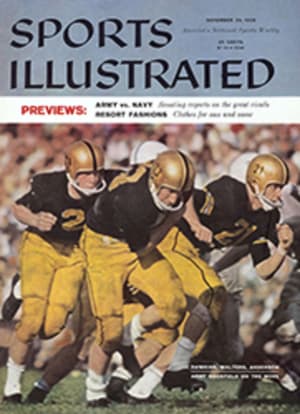
BEST OF THE TOUGHEST
Until last Saturday afternoon, there were those who said the 1958 Iowa Hawkeyes were the best football team the Big Ten had seen in five years. They could score with demoralizing suddenness from any place on the field, through the air or on the ground. Their line was tough and determined. They had wonderful spirit and a great coach. They couldn't lose because they wouldn't lose.
Then, on that dark and gloomy day in Iowa City last week, a brutal big team from Ohio State proved that for one afternoon, at least, Iowa was not even the best team in the Big Ten this year. Led by a tank in cleats named Bob White, the Buckeyes ground out touchdown after touchdown and the fifth one proved to be enough for victory. Ohio State, unable to win any one of its three previous games, beat Iowa 38-28. In the Big Ten this surprised hardly anyone. That is the way things happen in the toughest of all football leagues.
White, a big, redheaded fullback, pounded through the Iowa defense for three touchdowns, and for the second year in a row he ruined Iowa's hopes for its first undefeated season since 1922. Some said that to Iowa the game didn't really mean very much. The Hawkeyes had already clinched the Big Ten championship a week before and were going to the Rose Bowl regardless of what happened against Ohio State. But they were wrong. The game was important to Iowa because every game is important to Iowa, which is one reason it is such a good football team.
By the thousands, along the spider-web of concrete lacing the state of Iowa, Iowans had roared into town for this big one, driving through the lovely, rolling countryside of the eastern portion of the state, on past the green-and-brown checkerboard of the fields, past the fat hogs rooting happily through the stubbles of corn, past the woolly sheep and the sleek Holsteins and Herefords dotting the land, past the big, neat farmhouses with their silos rising like exclamation points against the late autumn sky. They had come to see the football team—their football team—which had inflated Iowa pride and captured Iowa imagination perhaps more than any other in years.
When it was all over, the great crowd which jammed Iowa Stadium was disappointed in the result, but for entertainment the game on Saturday was just about as good as anything even an Iowa fan could hope to see. "If I had been in the stands," said Iowa Coach Forest Evashevski, "I guess I might have enjoyed this game myself."
Even in defeat, their only defeat of the year, the Hawkeyes showed what it means to be tough. Never ahead, they came back once, twice, three times and still a fourth to tie up the contest, striking with beautiful precision and remarkable speed from Coach Evashevski's finely tuned wing-T offense, then passing Ohio State dizzy when the Buckeye defense bunched to stop the running plays.
There has long been a tendency in college football to place the successful coach on a pedestal, to overpublicize his contributions while downgrading those of the players who actually get their faces dirty and do the manual work. But no one denies that Evashevski deserves whatever praise he may receive for the job done in Iowa City. A big, ruggedly attractive man with one of the game's most imaginative brains, he has brought Iowa back to football respectability, and this 1958 team, in many ways his finest product, has been molded from beginning to end by his own inspired touch.
Evashevski was hardly a stranger to Iowans even on the day he arrived, for they remember that Michigan, with Evy out ahead blocking for Tom Harmon, handed Iowa's Darlings of Destiny, the great 1939 Nile Kinnick team, its lone defeat. Today he is perhaps the best-known man—and almost certainly the most popular one—in the entire state.
A man of many moods, he can be charming or tough, gracious or forbidding as the occasion requires. Articulate rather than glib, he is considered an excellent speaker, a talent which has been applied with success to stubborn alumni and potential star halfbacks as well as banquet audiences. But because he is quiet and thoughtful rather than outspoken, when he does speak, folks in Iowa stop and listen to what he has to say.
Of even more importance to the Iowa football program, folks stop and listen in other sections of the country. When Evy checked into Iowa in 1952, there were 56 Iowans on the 71-player squad and only four of the foreign 15 came from outside the Iowa-Illinois-Missouri area. Quick to realize that the state, with its relatively small population, was not going to supply enough players of Big Ten championship caliber, Evashevski went to work gathering them in from outside as well. This year 43 players of the 63-man squad are from other states, including eight from Michigan, five from Ohio and three each from the outer spaces of California and New Jersey. And this year's freshman team, a group of young mastodons who could be mistaken for the Chicago Bears, has no fewer than 10 Michiganders among its number—which may account for what has been happening to Michigan and Michigan State on various Saturday afternoons this fall.
As a tactician on the field, Evashevski is ranked at the top. Never afraid to try something new, he has gone from the multiple offense to the split-T to the wing T, sometimes even changing his attack before a specific game to confound the opposition. That his most recent offense, the wing T with a balanced line and old-fashioned, single-wing, two-on-one power blocking, happens to be the one currently in use at LSU, where dwells the nation's No. 1 team, is no coincidence. Last summer Evy went to Louisiana to conduct a coaching clinic and gave LSU Coach Paul Dietzel a few tips.
BIG TEN MONOPOLY
Together, Iowa and Ohio State have monopolized the Big Ten championship for the past five years. Evy's teams have won 22 of their last 28 conference games, losing twice to Michigan, twice to Ohio State and being tied once by the Wolverines. Across Iowa, despite Saturday's loss, they are happy with their football team once again.
In early September it was publicly pronounced by those who felt themselves qualified to know—this being a rather large group with no particular entrance requirements—that Iowa would have a good team, one of the best in the Big Ten, along with Ohio State and Michigan State and Wisconsin and Purdue. But, while admitting the effectiveness of the Iowa offense, the heads of the experts wagged sadly over the plight of Iowa's interior line. Even Evy himself, a man who leans neither toward excessive pessimism nor optimism but likes to say what he believes is true, could only promise that the defense was going to present a problem. "I think we will move the ball well," he said, "but we will also be very generous on defense."
The savage play of guards and tackles like Alex Karras and Dick Klein and Frank Bloomquist and Bob Commings had enabled the 1957 team to play through a tough schedule with the loss of only one game (and the championship, by a score of 17-13, to Bob White and Ohio State), and now they were gone. These were not just any guards and tackles, either, but great ones. Karras was twice an All-America and the others were close behind. And now in '58 Evy had no one to replace them. He felt that Tackles John Burroughs and Mac Lewis, Guards Gary Grouwinkel and Hugh Drake and Center Bill Lapham, all lettermen, could do a good job, but he doubted that they could do it all without help—and where was the help going to come from?
The starting line held up all right when Iowa beat a good TCU team in the season opener, but the next week, overconfident and entirely unprepared for the quality of football displayed by an Air Force Academy outfit that no one was taking too seriously just yet, Iowa almost came apart at the seams. Tackling like a bunch of grade-school kids on a picnic and outplayed all over the field by a Falcon team which had been doubly inspired by the presence of its cadet corps, Iowa considered itself fortunate to escape with a 13-13 tie.
"I think this demonstrated conclusively," says Evy, who uses words like that, "that we are not the kind of team which can win with 75% effort."
In the six games since, 100% effort has been a Hawkeye trademark. Indiana was an easy victim, and Michigan, too (for the first time in 34 years), and also Minnesota. But it was in the games against Wisconsin and Northwestern that Iowa really proved itself a football team. Wisconsin, No. 4 in the nation that week, almost ran Iowa off the field in the first half and led by 9-0. But in the last two quarters the Hawkeyes turned the big Badgers upside down, and the final 20-9 score was hardly indicative of Iowa's superiority. The unbeaten Northwestern bubble popped just as convincingly. Iowa scored three times before Coach Ara Parseghian's Cinderella team could get into the game and then, when it seemed that Northwestern might win after all, the Hawkeyes marched 73 jolting, determined yards to put the contest safely away. For the few who remain unconvinced that Iowa has had a really tough schedule, it might be pointed out that three of its opponents—TCU, Air Force, Wisconsin—haven't lost a game since.
PHOTO
OHIO STATE'S BOB WHITE (33) GETS THAT TRADITIONAL POSTGAME RIDE AFTER HIS THREE TOUCHDOWNS HELPED DEFEAT IOWA
PHOTO
TOTEM POLE is formed by Stanford End Chris Burford and Oregon State tacklers who helped keep OSC's bowl hopes alive.
PHOTO
LEFTWARD-BOUND PLAY shows Oregon's Dave Powell (41) taking pitchout from Quarterback Dave Grosz (10) for gain behind Dave Grayson (30). UCLA won 7-3.
PHOTO
RIGHTWARD-BOUND PLAY shows Grayson taking ball from Grosz, this time with interference provided by Powell, Will Reeve (60), Bob Grottkau (62) and Grosz himself.
PHOTO
REAR VIEW of Oregon play shows how Quarterback Grosz looks to his backfield teammates. Marlan Holland (44) took this pitchout and completed a quick six-yard pass.

